Punjab State Board PSEB 8th Class Social Science Book Solutions History Chapter 15 The Revolt of 1857 Textbook Exercise Questions and Answers.
PSEB Solutions for Class 8 Social Science History Chapter 15 The Revolt of 1857
SST Guide for Class 8 PSEB The Revolt of 1857 Textbook Questions and Answers
I. Answer the following questions:
Question 1.
Write down any two political causes of the revolt of 1857 A.D.
Answer:
1. Insult of Bahadur Shah: In 1856 A.D., the Governor-General told the Mughal Emperor that he would be the last emperor of India. After his death, his princes will have to vacate the Red fort. This decision of the British annoyed the Muslims.
2. Unjustified annexation of Avadh: Avadh remained a faithful friend of the British but its unjustified annexation annoyed the people.
Question 2.
Which punishment was given to Bahadur Shah Zafar?
Answer:
He was taken prisoner and sent to Rangoon. After some time, Bahadur Shah Zafar died and the Mughal empire came to an end. His two sons were shot dead.
Question 3.
Write down the immediate cause of the revolt of 1857 A.D.
Answer:
The episode of the greased cartridges was the immediate cause of rising on May 10, 1857. Some Indian soldiers at Meerut refused to use a new type of cartridge which were greased with the fat of the pigs and cows. A portion of the cartridge had to be bitten with one’s teeth before it could be fired. This enraged the Hindu and Muslim soldiers in the British army. They refused to obey the orders of their British officers to use the cartridges and rose in revolt.
![]()
Question 4.
With which other two names the revolt of 1857 A.D. is known?
Answer:
The first war of Independence and Soldier Revolt.
Question 5.
Write down in brief the social causes of revolt of 1857 A.D.
Answer:
- The Christian missionaries were propagating Christianity in India. They insulted Hindu and Muslim religions while propagating Christianity. The Government never put any restrictions on their activities. So, the Indians were annoyed with this policy of the British.
- In 1856 A.D. Religious Inability Act was passed. According to this Act, if someone changed his religion, he could get the share of his father’s property. Bypassing this law, the government encouraged the people to embrace Christianity.
- The British did not treat Indians well. They called Indians ‘Rustics’ and ‘Black Indians’. Indians could not bear this insult. This also become a cause of the revolt of 1857.
Question 6.
Write down the causes of failure of the revolt of 1857 A.D.
Answer:
The following were the main causes of failure of Indians in the rising of 1857 :
- The day of 31st May, 1857 was fixed for the start of revolt. But it started on 29 March. Rebels were not fully prepared for the revolt.
- Revolt did not spread in entire India.
- Unity was lacked among rebels.
- Rebels lacked means to carry on the revolt.
- Rebels were not fighting for any common objectives.
- Military generals of rebels were not capable objectives.
- Some local kingdoms helped the British to crush the revolt.
- Means of transport were under control of British.
- Intelligence system of the British was very good.
- They crushed the revolt with the help of their military.
II. Fill in the Blanks :
Question 1.
The cartridges were greased with the fat of cow and ________
Answer:
pig
![]()
Question 2.
Many states annexed to the British Empire according to the Doctrine of Lapse of Lord
Answer:
Dalhousie
Question 3.
First of all the revolt of 1857 A.D. was started in ________
Answer:
Barrakpur
Question 4.
________ was a famous general of Nana Sahib.
Answer:
Tanya Tope
Question 5.
Indian soldiers declared their emperor.
Answer:
Bahadur Shah Zafar.
III. Write ‘True’ or ‘False* in the brackets given after each statement:
Question 1.
Indians were appointed on high posts.
Answer:
False
![]()
Question 2.
Good treatment was given to the Indians by the Britishers.
Answer:
False
Question 3.
The British made many social reforms.
Answer:
True.
Question 4.
Gradually Indian industry and trade declined.
Answer:
True.
Question 5.
The Britishers ’adopted the policy of ‘Divide and Rule’.
Answer:
True.
IV. Something To Do :
Question 1.
To know about Lakshmi Bai, queen of Jhansi.
Answer:
Do it yourself with the help of your teacher.
![]()
Question 2.
Collect the pictures of prominent freedom fighters and paste them in your scrapbook.
Answer:
Do it yourself with the help of your teacher.
PSEB 8th Class Social Science Guide The Revolt of 1857 Important Questions and Answers
Multiple Choice Questions :
Question 1.
When did first war of Independence take place?
(a) 1857 A.D.
(b) 1897 AD.
(c) 1947 AD.
(d) 1965 A.D.
Answer:
(a) 1857 A.D.
Question 2.
What was the demand of Rani Lakshmibai of Jhansi from the British?
(a) To adopt a daughter
(b) To adopt a son
(c) To give her back her kingdom
(d) To give her pension.
Answer:
(b) To adopt a son.
Question 3.
What was the immediate cause of revolt done by Indian Sepoys?
(a) Use of Canons
(b) Use of new machines.
(c) Use of fat coated cartridges
(d) All of these
Answer:
(c) Use of fat coated cartridges.
![]()
Question 4.
Who was the last Mughal Emperor?
(a) Akbar
(b) Aurangzeb
(c) Jahangir
(d) Bahadur Shah Zafar
Answer:
(d) Bahadur Shah Zafar.
Question 5.
Where was Bahadur Shah Zafar exiled and died?
(a) New Delhi
(b) Kanpur
(c) Rangoon
(d) Nepal.
Answer:
(c) Rangoon.
Question 6.
When did Bahadur Shah Zafar die?
(a) 1857 A.D.
(b) 1862 A.D.
(c) 1860 A.D.
(d) 1865 A.D.
Answer:
(b) 1862 A.D.
Question 7.
From where did the Indian revolt of 1857 start?
(a) Delhi
(b) Meerut
(c) Kanpur
(d) Jhansi.
Answer:
(b) Meerut
Question 8.
________ was proclaimed as emperor of India in 1857.
(o) Bahadur Shah Zafar
(b) Tantya Tope
(c) Nana Saheb
(d) Aurangzeb.
Answer:
(a) Bahadur Shah Zafar.
![]()
Question 9.
________ was the first martyer of the revolt of 1857.
(a) Nana Saheb
(b) Mangal Pandey
(c) Rani Laxmi Bai
(d) Tantya Tope,
Answer:
(b) Mangal Pandey.
Question 10.
________ led the revolt of Kanpur.
(a) Tantya Tope
(b) Rani Laxmi Bai
(c) Nana Saheb
(d) Kunwar Singh.
Answer:
(c) Nana Saheb.
Question 11.
Rani Lakshmi Bai died at
(a) Kanpur
(b) Gwalior
(c) Nagpur
(d) Satara.
Answer:
(b) Gwalior.
Question 12.
What was the long term result of revolt of 1857?
(a) Rise of Indian Nationalism
(b) Creation of Awareness
(c) End of Company’s rule
(d) All of these.
Answer:
(a) Rise of Indian Nationalism.
![]()
Question 13.
When was Awadh annexed into the British Empire?
(a) 1850 A.D.
(b) 1856 A.D.
(c) 1860 A.D.
(d) 1857 A.D.
Answer:
(b) 1856 A.D.
Question 14.
Who introduced Policy of Lapse in India?
(a) Lord William Bentinck
(b) Lord Dalhousie
(c) Lord Wellington
(d) None of these.
Answer:
(b) Lord Dalhousie.
Question 15.
Who resented high taxes in countryside?
(a) Peasants
(b) Zamindars
(c) Jotdars
(d) All of these.
Answer:
(d) All of these.
Question 16.
Which of these reforms was introduced by the British?
(a) Ban on Sati Pratha
(b) Permission of Widow remarriage
(c) Introduction of Western Education System
(d) All of these.
Answer:
(d) All of these.
![]()
Question 17.
Identify the event with which the persons given in the picture were associated:

(a) First World War
(b) Revolt of 1857
(c) Peasant Revolt
(d) Indigo Revolt.
Answer:
(b) Revolt of 1857.
Question 18.
The given picture is of Rani Laxmi Bai whose kingdom was annexed by the British under a policy called ________
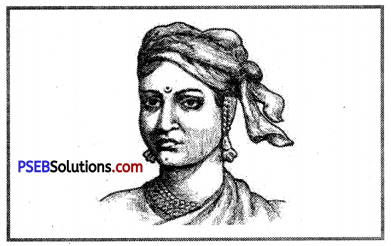
(a) Subsidiary Alliance
(b) Doctrine of Lapse
(e) Policy of Paramountcy
(d) Through Conquests.
Answer:
(b) Doctrine of Lapse.
Question 19.
The person in the given picture was declared the leader of the 1857 revolt. Name the person.
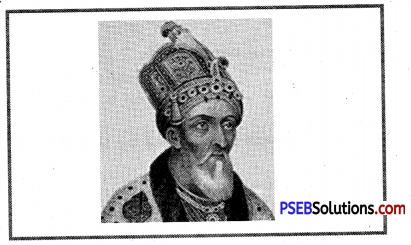
(a) Tantya Tope
(b) Raja Kanwar Singh
(c) Bahadur Shah Zafar
(d) Nana Saheb.
Answer:
(c) Bahadur Shah Zafar.
![]()
Question 20.
The person in the given picture is known as the first martyr of the revolt of 1857 AD. Name the person.
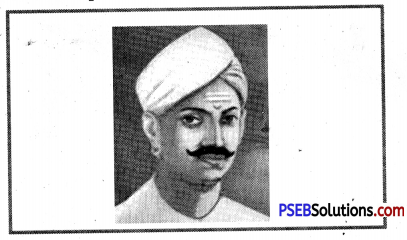
(a) Tantya Tope
(b) Mangal Pandey
(c) Kanwar Singh
(d) Nana Saheb.
Answer:
(b) Mangal Pandey.
Fill in the Blanks :
Question 1.
The cartridges were filled with the fat of cow and ________
Answer:
pig
Question 2.
According to Doctrine of Lapse of Lord ________, many Indian Kingdoms were captured.
Answer:
Dalhousie
Question 3.
Initially, the revolt started at ________
Answer:
Barrackpur
![]()
Question 4.
________ was a famous general of Nana Sahib.
Answer:
Tantya Tope
Question 5.
Indian soldiers declared ________ at their leader.
Answer:
Bahadur Shah Zafar.
Tick the Right (✓) or Wrong (✗) Answer :
Question 1.
During British times, Indians were appointed at higher posts.
Answer:
(✗)
Question 2.
Indians were behaved quite well.
Answer:
(✗)
Question 3.
The British introduced many social reforms here in India.
Answer:
(✓)
Question 4.
Gradually Indian trade and industries declined.
Answer:
(✓)
![]()
Question 5.
The British adopted the policy of ‘Divide and Rule’.
Answer:
(✓)
Match the Following :
Question 1.
| A | B |
| 1. Nawab Wajid Ali Shah | (i) Delhi |
| 2. Nana Sahib | (ii) Avadh |
| 3. Bahadur Shah Zafar | (iii) Kanpur |
| 4. Sardar Ahmed Khan Kharal | (iv) Punjab |
Answer:
| A | B |
| 1. Nawab Wajid Ali Shah | (ii) Avadh |
| 2. Nana Sahib | (iii) Kanpur |
| 3. Bahadur Shah Zafar | (i) Delhi |
| 4. Sardar Ahmed Khan Kharal | (iv) Punjab |
Very Short Answer Type Questions
Question 1.
Write two religious causes of the Revolt of 1857 A.D.
Answer:
- The British were converting Indians into Christians by promising them many concessions.
- The English passed Religious Inability Act, 1856 to spread Christianity.
Question 2.
Write two political causes of Revolt of 1857 A.D.
Answer:
- There was discontentment among the Indian rulers because of the policy of the subsidiary alliance and the Doctrine of Lapse.
- Title of Emperor was taken away from the Mughal Emperor Bahadur Shah Zafar. He was, therefore, annoyed with the British.
![]()
Question 3.
Write the names of the main leaders of the. Revolt of 1857 A.D.
Answer:
Names of four important leaders of the revolt were:
- Nana Sahib
- Tantya Tope
- Rani Laxmi Bai and
- Kanwar Singh.
Question 4.
Give two reasons of the failure of Revolt of 1857 A.D. in Punjab.
Answer:
Revolt of 1857 A.D. failed in Punjab due to two following reasons :
- There was no capable leader of rebels.
- Instead of giving help to rebels, the kings of Patiala, Nabha and Jind gave their support to the British.
Question 5.
Which were the four main centres of the Revolt of 1857 A.D.?
Answer:
Meerut, Delhi, Kanpur and Lucknow.
Question 6.
Who was Tantya Tope?
Answer:
Tantya Tope was the General of Nana Sahib. He was the leader of army of Nana Sahib in the revolt. When the British took control of Kanpur, he helped Rani Laxmi Bai.
Question 7.
Why did the Rani of Jhansi took part in the Rising of 1857 A.D.?
Answer:
Rani of Jhansi took part in the rising of 1857 because the British did not allow her to adopt a heir to the throne of Jhansi.
Question 8.
Write two political consequences of the Revolt of 1857 A.D.
Answer:
- The rule of the East India Company came to an end. India came under the direct rule of the British Crown i.e. the King and the Parliament of Britain.
- The British Government abandoned the policy of annexing Indian States.
![]()
Question 9.
Write two social effects of the Revolt of 1857 A.D.
Answer:
- It created bitterness between the Hindus and the Muslims.
- The Indians and the Europeans began to hate each other.
Question 10.
Give any two economic effects of the Revolt of 1857 A.D.
Answer:
- After the Sepoy mutiny of 1857, the British purchased raw material at cheap rates from the Indian markets and sent it to England.
- They had a monopoly in the trade of Tea, Coffee, Tobacco, Cotton, etc.
Question 11.
In which cantonments of Punjab revolt occurred in the Revolt of 1857 A.D.?
Answer:
During the revolt of 1857 A.D. revolt occurred in cantonments of Lahore, Firozpur, Peshawar, Ambala, Mianwali etc. of Punjab.
Question 12.
What was the contribution of Sardar Ahmed Khan Kharal in the revolt?
Answer:
Sardar Ahmed Khan Kharal refused to pay tax to the government and rose in revolt against it. He fopght against the English at some places. Ultimately he died while fighting the British near Pakpattan.
Question 13.
Why Nana Sahib became opponent of the British?
Answer:
Peshwa Baji Rao II died in 1857 A.D. But after his death, Lord Dalhousie stopped the pension of his successer i.e. Nana Sahib. That’«s why he became opponent of the British and revolted against them.
Question 14.
How many soldiers at Merrut refused to use the greased cartridges?
Answer:
Nearly 85 soldiers in Merrut refused to use the greased cartridges.
![]()
Question 15.
Who occupied Delhi on 11th September?
Answer:
General Nicklson occupied Delhi on 11th September with the help of the Sikh soldiers.
Short Answer Type Questions
Question 1.
Where and why did the Revolt of 1857 start?
Answer:
The Revolt of 1857 started at Barrackpur cantonment, Bengal in March. A soldier named Mangal Pandey shot an English officer. He was hanged for this crime. This incident inspired his fellow soldiers with patriotic feelings and they later joined the revolt against the British on 10th May, 1857.
Question 2.
Why were the soldiers of Avadh against the British?
Answer:
The army of Bengal was the best army of the East India Company. A majority of the soldiers in the army belonged to Avadh. Lord Daihousie annexed Avadh into the British Empire. Avadh soldiers did not like it and turned against the British. The English disbanded the Avadh army as a result of which thousands of soldiers became unemployed. They decided to rise in revolt in protest.
Question 3.
Why did the Indian soldiers take part in the Revolt of 1857 A.D.?
Answer:
Following are the reasons of taking part of Indian soldiers in the Revolt of 1857 A.D. :
- In 1856, one law was passed according to which soldiers could be sent beyond the sea in a war. But in Hindu religion, it was considered that going beyond the sea is against religion.
- Indian soldiers were badly treated during the Parade. It was unbearable for the Indian soldiers to tolerate this disrespect.
- Indian soldiers were given very less salary as compared to the British soldiers. That’s why resentment spread among them.
- The British officers disrespected the culture of Indian soldiers in front of them. Indian soldiers wanted to take revenge of this disrespect.
![]()
Question 4.
Describe the military consequences of the Revolt of 1857 A.D.
Answer:
Following were the military consequences of the revolt :
1. Consolidation of the Army: There were two types of soldiers before the revolt.
- The soldiers appointed by the Company and
- The soldiers appointed by the British government. After the revolt, the two armies were unified.
2. Increase in the number of European Soldiers: The number of European soldiers was increase^ and the number of Indian soldiers was decreased. But the Sikhs of Punjab and the Gorkhas of Nepal were given preference in the recruitment in the army.
3. Reorganisation of Indian Army: Artillery was put under the charge of the British soldiers. Indian soldiers were given weapons of low quality.
Question 5.
Describe the event of Lucknow at the time of the Revolt of 1857 A.D.
Answer:
Lucknow, the capital of Avadh, was the centre of revolt. The rebels uprooted the British administration in this area. The British Commander-in-Chief Havlock marched on Lucknow with a large force and captured it on 31st March, 1858. After sometime, the large landlords of Avadh also lay down their arms. Thus the revolt was crushed in Avadh.
Question 6.
Discuss the importance of freedom struggle of 1857 A.D. in the history of our country on the basis of four things.
Answer:
The First War of Independence was the most important event in the history of India. Its importance may be studied as under :
- It was the first attempt made by the Indians for the achievement of freedom. Indian soldiers and public collectively faced the enemy in this war of independence. Thus this struggle was a symbol of Indian national unity.
- People of all castes, creeds and religions made joint efforts to achieve freedom.
- The British were alarmed as a result of this revolt and they made several reforms in the administration to please the Indians.
- Several Indians sacrificed their lives in this struggle. The sacrifices of these persons always inspired the coming generations of India.
![]()
Question 7.
Write down a note about Regional Focus: Avadh.
Answer:
Avadh was a very prosperous state. Nawab Wajid Ali Shah of Avadh always remained loyal to the Britishers. But Britishers started to interfere in his kingdom. He was forced to keep the British army in his kingdom. After some time whole of his army was relieved and kept British army over there. Whole expenditure of the British army was on Nawab. All the relieved soldiers of army of Nawab became unemployed. In 1856 A.D., Britishers accused Nawab of mis government of Avadh and removed him. Then his kingdom was annexed into the British empire. Soldiers, formers and zamindars got annoyed with this and they took part in the revolt of 1857 in great number.
Question 8.
Write a note on “Doctrine of Lapse”.
Answer:
The Doctrine of Lapse was adopted by Lord Dalhousie. According to this doctrine, succession to protected state depended upon the will of the British. Lord Dalhousie decided that if the ruler of a dependent state had no male child, he could not adopt a son. It meant that if a native ruler died without leaving a son behind, the dependent state would pass into the hands of the British. On the grounds of Doctrine of Lapse, Dalhousie annexed seven dependent kingdoms into the British Empire which included Nagpur, Jhansi, Jaipur and Satara.
Long Answer Type Questions
Question 1.
Write down the main causes of the Revolt of 1857.
Answer:
The main causes of the Revolt of 1857 were as follows :
1. Political Discontentment: There was a great resentment among the Indian masses on account of wrong political policies of the British. Lord Dalhousie annexed several Indian states on the basis of the Doctrine of Lapse. The rulers, the public and employees of these states turned against the British. The British ruined village self-government. They did not promote the Panchayat system. They also gave setback to village cottage industries. So the villagers too had feelings of hatred against the British.
2. Shortcomings in the Administration: Corruption was rampant in the British administration. Justice was very costly. Land tax system was very faulty and harsh. Actually, the main aim of the British was to collect more and more money. The British rule in India was, therefore, most unpopular.
3. Economic Exploitation: To promote industry in England, the British ruined Indian industries. Now, only the British made goods were sold here. Farmers too were greatly exploited by the Company. All high jobs were given to the British who got their salaries from Indian exchequer. So this exploitation of Indians increased the discontentment against the British rule.
4. Interference in the Religious Matters: The British took many steps to convert the Indians into Christianity. They also tried to change religious customs of the Indians. As a result, Indians belonging to all religions turned against the English.
5. Discontentment in the Army: There was discontentment among Indian soldiers. They were given very low salaries. The British soldiers misbehaved with them. In 1856, Indian soldiers were supplied greased cartridges for use. Soldiers were enraged and rose in revolt.
![]()
Question 2.
What were the causes of the failure of Rising of 1857?
Answer:
The following were the main causes of the failure of Indians in the Rising of 1857:
1. Beginning of the Revolt before time: The rebellion started before time because of the incidents at Behrampur, Barrakpur and Meerut. Unity among the revolutionaries received a setback and the English got sufficient time to suppress the revolt.
2. No common aim: The leaders participating in the struggle did not have any common goal. Some were fighting for the cause of religion, some for the safety of their states, while some others for the independence of the country. Therefore, the failure of revolution was certain.
3. Revolt Unorganised: The rebels had no able leader who could have kept them united. They were unorganised and indisciplined.
4. Untrained Soldiers: The rebels lacked trained soldiers. They had no modern weapons of war. Most of the people who participated in the rising were disbanded soldiers. They had little experience. The rising was bound to fail.
5. The rising did not spread in the whole country: This struggle remained restricted only to the northern India. People of South India did not take active part in it. Had the whole of India stood united against the British, the first war of Indian Independence would not have failed.
6. Control of the British over the means of transport: All the means of transport and communication like railways, post and telegraph etc. were in the hands of the British. They were in a position to send soldiers and weapons of war from one place to another place easily.
7. Harsh methods of the British to suppress the Revolt: The British dealt with revolutionaries very cruelly. Cities were looted and burnt. Many people were hanged. Public got frightened and did not take part in the rising.”
8. Economic difficulties: The rebels lacked money. They were not in a position to purchase good weapons. As a result, they failed in their mission.
Question 3.
Describe the results of the Revolt of 1857 A.D.
Answer:
The rising of 1857 A.D. had some very important results which were as under :
1. Political results:
- The rule of the company in India came to an end. India, now, came under the direct control of the British government in England.
- The Governer-General of India was given the new title of Viceroy.
- Mughal rule in India came to an end.
- Indian kings were given permission to adopt son.
- After 1857, British discontinued the policy of annexing Indian States into the British Empire.
2. Social results:
- On 1st of Nov. 1858, Queen Victoria of England proclaimed a Declaration in which it was said that the British government would not interfere in the religious matters of the Indians. Indians would be given jobs on merit and they would also be given higher posts.
- The British adopted the policy of divide and rule. They started favouring one particular religion and people of one class were made to fight with the people of other class so that their interests in India could be protected.
3. Military results:
- The number of Indian soldiers in the army was reduced and that of the Europeans increased.
- After the rising, artillery and ammunition departments were put under the control of British soldiers.
- Now the soldiers of different castes and different religions were kept into separate regiments so that they could not start revolt again against the Britishers.
- European soldiers were appointed on higher and important posts. Indian soldiers were given less important positions.
- Some type of system was made in which Indian soldiers and officers of every level should remain under the supervision of European army.
- Expenses of European army were put on Indian people.
4. Economic results: Many type of trade restrictions were imposed on Indians by British government. As a result, Indian trade suffered huge losses.
![]()
Question 4.
Explain the four main events of Revolt of 1857 A.D.
Or
Describe the main events of Revolt of 1857 A.D.
Answer:
The Indians rose against the British on a large scale for the first time in 1857. Plan for the rising was ready. The message of rising was .sent to soldiers and the public by circulation of roses and chapatis. 31st May, 1857 was fixed for the revolt, but the incident of greased cartridges at Meerut led to the beginning of rising on 10th May.
An account of the events of this rising is as under :
1. Barrakpur. Greased cartridges were supplied to the soldiers stationed at Barrakpur, a cantonment in Bengal on 29th March, 1857 A.D. A soldier named Mangal Pandey refused to use them. In a fit of anger, he shot dead an English officer and asked his companions to pounce upon their British Officers. Mangal Pandey was sentenced to death. All the soldiers of Barrakpur Cantonment got enraged by this incident. Mangal Pandey was the first martyr of the revolt of 1857.
2. Meerut. The fire of revolt engulfed Meerut on 10th May, 1857. The Public and soldiers of Meerut came out in an open revolt against the British. The whole city echoed with slogans like “Maro Firangi Ko”. Soldiers broke open the gates of jails and released their companions. From there, they marched to Delhi.
3. Delhi. The English officers tried to check rebels at Delhi, but they failed to do so. The rebels declared Bahadur Shah as their king and Delhi came under their control within four days.
On 14th September, 1857 differences arose among the rebel soldiers at Delhi. British took advantage by this rift and re-established their control over Delhi. Terror was let loose on the citizens. Bahadur Shah was arrested and sent to Rangoon. Both of his sons were killed.
4. Kanpur. Nana Sahib declared himself as Peshw’a at Kanpur. The British commander Havlock defeated Nana Sahib and the control of Kanpur came in the hands of the English. Tantya Tope tried to re-establish his control there but failed. In the mean time Nana Sahib took shelter in Nepal. Tantya Tope fled and went over to Rani of Jhansi.
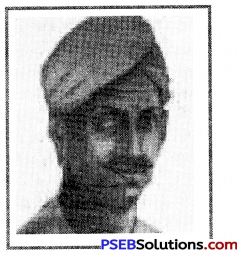
Mandal Pandey
5. Lucknow. Lucknow was the capital of Avadh. The English commander Havlock invaded Lucknow with a large army and established his control over the city on 31st March, 1858. After some time, “Talukedars” of Avadh also laid down their arms and as such the fire of revolt in Avadh was also extinguished.
6. Jhansi. Rani Lakshmi Bai of Jhansi led the rising. The British commander attempted to suppress the revolt and occupy Jhansi but failed. Jhansi was again invaded in April, 1858 A.D. This time a few companions of Rani Lakshmi Bai deserted her and joined the British. They however, faced bravely the aggressors. The fort of Jhansi came under the control of the British. The Rani was killed in a battle with the British near Gwalior. In the Central India, Tantya Tope fought many battles with the English but was defeated. He was captured and hanged on April 18th, 1858.
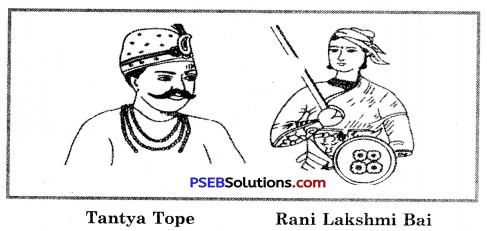
7. Punjab. Yet many rulers of states of Punjab helped the Britishers in revolt, but still revolt occurred at many places against Britishers. Indian soldiers revolted at Ferozpur, Peshawar, Jalandhar and at some other places. But these revolts were suppressed by Britishers and many soldiers were killed.
In modern Harvana, local leaders of Rewari. Bhiwani, Balabhgarh, Hansi, etc. also revolted in 1857 A.D. but they were also suppressed by Britishers.
![]()
Question 5.
Explain the political, economic and military causés of the Revolt of 1857 A.D.
Answer:
In 1857, Indians revolted against the British for the first time. They wanted to drive them away from their country. This revolt is considered as the ‘First War of Independence’. Political, military and economic causes of this revolt were as under :
I. Political Causes:
1. Annexationist Policy of Daihousie. LMrd Daihousie wanted the expansion of the British empire in India. He. therefore, adopted the policy of annexation through the Doctrine of Lapse. According to this policy, a ruler who had no male heir was not allowed to adopt a son who might inherit his kingdom. He annexed Satara, Nagpur. Sambalpur, Jaitpur etc. to the British Empire. By following this policy, the British did not allow the widow queen of Jhansi to adopt a son. She, therefore, became a bitter enemy of the British.
2. Injustice with Nana Sahib. Nana Sahib was the adopted son of the last Maratha Peshwa Bajirao II. After the death of Bajirao, the British refused to pay annual pension to Nana Sahib. So, he turned against the British. On seeing injustice done to Rani of Jhansi and Nana Sahib, the Indians were annoyed and felt insulted. They began to make plans to end the British rule in India.
3. Insult of Bahadur Shah. In 1856 A.D, the Governor-General told the Mughal Emperor Bahadur Shah that he would be the last Emperor of India. After his death, his princes will have to vacate the Red Fort and stay in a rented house near Qutub Minar. This decision of the British annoyed Bcgam Zeenat Mahal, the queen of Bahadur Shah. She started hatching conspiracies to destroy the British rule in India. The Muslim population of the country could not bear this insult to the heir of Akbar and Aurangzeb.
4. Unjustified annexation of Avadh. Nawab Wajid Ali Shah of Avadh was a faithful friend of the British. His ancestors had also helped the British several times. Even then, the British levelled the charge of maladministration against the Nawab of Avadh and annexed his kingdom to the British empire. They gave pension to Wajid Ali Shah and sent him to Calcutta (Kolkata). The people of Avadh got annoyed over it. There were 60,000 Avadh soldiers in the army of Bengal. They could not tolerate this injustice done to their king and decided to rise in revolt against the British.
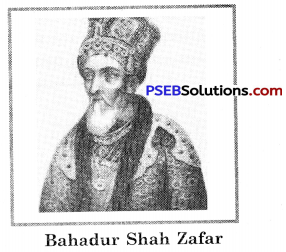
II. Military Causes:
- Low Salaries: The salaries of Indian soldiers were very low. They were not given higher salaries even if they were qualified. Chances of their promotion were very less.
- Misbehaviour of the Europeans: Indian soldiers were considered to be inferior to European soldiers and English officers used to maltreat the Indian soldiers.
- The Enlistment Act of 1856: An Act was passed in 1856 by which, it was made obligatory for the soldiers to go overseas if ordered. As a result of it, dissatisfaction spread among the Indian soldiers.
- Annexation of Avadh: The British annexed Avadh on the basis of maladministration. The Nawab was deposed and his army was disbanded.
- The issue of Greased Cartridges: In 1856 A.D, Indian soldiers were given greased cartridges which were to be bitten with one’s teeth before they could be fired. This enraged the Hindu and Muslim soldiers in the British army. Indian soldiers were angry over it. The first freedom struggle of 1857 A.D. was the result of this discontentment amongst the Indian soldiers.
III. Economic Causes:
- The British started sending raw materials from India to factories in England. Finished products of England were sold in India. This policy affected Indian industry very badly and many artisans became jobless.
- The British increased the land tax step by step. This tax was collected by very harsh methods. The farmers were dissatisfied due to this reason.
- Import duties on Indian raw materials in England were high whereas import duties in India on British-made goods were low. Indian trade was, therefore, suffering from heavy losses.
- The British confiscated the Jagirs of many ‘Jagirdars’ and increased taxes on other ‘Jagirs’. As a result, many landlords turned against the British.
![]()
Question 6.
Explain the contribution of Punjabis in the revolt of 1857 A.D.
Answer:
The Punjabis had mixed reactions to the revolt of 1857. The Indian soldiers in some cantonments of Punjab faced the British army bravely, but some rulers of Punjab states sided with the British. As a result, The revolt of 1857 in Punjab could not succeed.
A brief description of the role of the Punjabis in the revolt of 1857 is as under:
1. Revolt by Soldiers. The uprising started on 10th May 1857 at Meerut. The news about the revolt reached Lahore on May 12th, 1857. Indian soldiers (called sepoys) at Mian Mir cantonment (near Lahore) were disarmed as there was danger of the spread of revolt in Punjab. After this, the Indian soldiers in the cantonments of Peshawar, Naushehra, Multan, Ambala, Jalandhar, Rawalpindi, Amritsar, Hoshiarpur, and Derajat were disarmed. Even then the soldiers in the eastern region revolted. The army created some disturbances at Jalandhar, Phillaur, Jhelum, and Thaneshwar. Hindustani and Punjabi soldiers revolted in other important cantonments also. Some soldiers killed their commanders.
2. Revolt by Common people. In view of the deteriorating condition of the British Government, the common people also revolted at several places. For example, people at Sialkot and Sirsa co-operated with the Indian soldiers. Besides, the Muslim tribals of Montgomery, Multan, Bahawalpur, and Fazilka also joined the revolt. Similarly, Punjabis rose in an open revolt at Karnal, Rohtak, and Rewari. Some jats of Karnal refused to pay the land tax to the British.
3. Revolt by Sardar Ahmed Khan Kharal. Ahmed Khan Kharal was the chief of a tribe. He refused to pay tax to the government and ro#e in revolt against it. Some tribals living on the banks of Ravi sided with him. He fought against the English at some other places also and killed the British soldiers and officers. Ultimately, he died while fighting the British near Pakpattan.